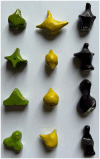Unilateral tactile agnosia as an onset symptom of corticobasal syndrome
- PMID: 39118817
- PMCID: PMC11308946
- DOI: 10.3389/fnhum.2024.1401578
Unilateral tactile agnosia as an onset symptom of corticobasal syndrome
Abstract
Tactile agnosia is the inability to recognize objects via haptic exploration, in the absence of an elementary sensory deficit. Traditionally, it has been described as a disturbance in extracting information about the physical properties of objects ("apperceptive agnosia") or in associating object representation with its semantic meaning ("associative agnosia"). However, tactile agnosia is a rare and difficult-to-diagnose condition, due to the frequent co-occurrence of sensorimotor symptoms and the lack of consensus on the terminology and assessment methods. Among tactile agnosia classifications, hyloagnosia (i.e., difficulty in quality discrimination of objects) and morphoagnosia (i.e., difficulty in shape and size recognition) have been proposed to account for the apperceptive level. However, a dissociation between the two has been reported in two cases only. Indeed, very few cases of pure tactile agnosia have been described, mostly associated with vascular damages in somatosensory areas, in pre- and postcentral gyrus, intraparietal sulcus, supramarginal gyrus, and insular cortex. An open question is whether degenerative conditions affecting the same areas could lead to similar impairments. Here, we present a single case of unilateral right-hand tactile agnosia, in the context of corticobasal syndrome (CBS), a rare neurodegenerative disease. The patient, a 55-year-old woman, initially presented with difficulties in tactile object recognition, apraxia for the right hand, and an otherwise intact cognitive profile. At the neuroimaging level, she showed a lesion outcome of a right parietal oligodendroglioma removal and a left frontoparietal atrophy. We performed an experimental evaluation of tactile agnosia, targeting every level of tactile processing, from elementary to higher order tactile recognition processes. We also tested 18 healthy participants as a matched control sample. The patient showed intact tactile sensitivity and mostly intact hylognosis functions. Conversely, she was impaired with the right hand in exploring geometrical and meaningless shapes. The patient's clinical evolution in the following 3 years became consistent with the diagnosis of CBS and unilateral tactile apperceptive agnosia as the primary symptom onset in the absence of a cognitive decline. This is the third case described in the literature manifesting morphoagnosia with almost completely preserved hylognosis abilities and the first description of such dissociation in a case with CBS.
Keywords: corticobasal syndrome; hyloagnosia; morphoagnosia; tactile agnosia; tactile object recognition.
Copyright © 2024 Facci, Basilico, Sellitto, Gelosa, Gandola and Bottini.
Conflict of interest statement
The authors declare that the research was conducted in the absence of any commercial or financial relationships that could be construed as a potential conflict of interest. The author(s) declared that they were an editorial board member of Frontiers, at the time of submission. This had no impact on the peer review process and the final decision.
Figures
References
-
- Bay E. (1944). Zum Problem der taktilen Agnosie. Dtsch. Z. Nervenheilkd. 156, 64–96. doi: 10.1007/BF01761340 - DOI
LinkOut - more resources
Full Text Sources
Molecular Biology Databases




